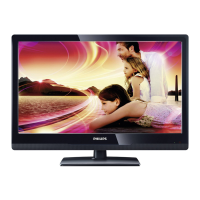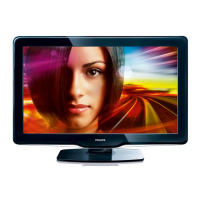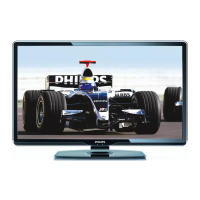
Do you have a question about the Philips 32PFL5206H/12 and is the answer not in the manual?
| Screen Size | 32 inches |
|---|---|
| Resolution | 1366 x 768 pixels |
| Display Technology | LCD |
| Screen shape | Flat |
| Aspect ratio | 16:9 |
| Response time | 5 ms |
| Contrast ratio (typical) | 1000:1 |
| Display brightness | 300 cd/m² |
| HD type | HD Ready |
| Supported graphics resolutions | 1366 x 768 |
| Number of speakers | 2 |
| USB Ports | 1 |
| USB 2.0 ports quantity | 1 |
| Component video (YPbPr/YCbCr) in | 1 |
| SCART ports quantity | 1 |
| Common interface (CI) | Yes |
| Common interface Plus (CI+) | Yes |
| VESA mounting interfaces | 200 x 100 mm |
| Refresh Rate | 50 Hz |
| Smart TV | No |
| Built-in Wi-Fi | No |
| Display diagonal | 81 cm |
| Supported video modes | 1080p |
| Digital signal format system | DVB-C, DVB-T |
Details regarding the warranty terms and conditions for the TV product.
Information about the characteristics of LCD pixels and acceptable variations.
Information regarding compliance with Electromagnetic Field (EMF) standards.
Instructions for replacing the mains fuse in the TV, specific to UK models.
Copyright notice for the product manual and associated content.
General safety precautions and warnings for using the TV and avoiding hazards.
Guidelines for cleaning and maintaining the TV screen to prevent damage.
Information on how to properly dispose of the old TV and its batteries.
Details on Philips' commitment to environmental sustainability in product design and recycling.
Identification and function of the physical controls on the TV set.
Overview of the remote control buttons and their functions.
Instructions and tips for effective use of the TV remote control.
Instructions on how to turn on the TV using the power switch or remote control.
Instructions on how to put the TV into standby mode using the remote.
Instructions on how to turn off the TV completely via the power switch.
Methods for changing TV channels using the remote control or TV buttons.
How to use the channel grid to preview available channels.
Guidance on selecting and viewing content from connected external devices.
Steps to select the desired input source from the TV's source list.
Alternative methods for switching TV channels, such as using numeric buttons.
Instructions for adjusting the TV's audio volume using the remote or TV buttons.
How to mute and restore the TV's audio output.
Guide on accessing and navigating teletext services.
How to navigate and access the TV's main menu system.
Instructions for adjusting picture and sound preferences.
Applying pre-defined picture settings for various viewing scenarios.
Detailed guide to manually adjusting individual picture settings.
How to change the aspect ratio of the displayed picture.
An overview of the available picture format options.
Applying pre-defined sound settings for optimal audio experience.
Detailed guide to manually adjusting individual sound settings.
Activating accessibility features for visually and hearing impaired users.
Exploring and utilizing advanced teletext functionalities.
Navigating through and selecting teletext subpages.
Using Table Of Pages (T.O.P.) for easier teletext navigation.
Creating and managing lists of preferred TV channels for quick access.
Displaying only the channels saved in the favourite list.
Switching the view to display all installed TV channels.
Adding or removing channels from the favourite list.
Accessing and utilizing the on-screen TV programme guide.
Steps to turn on and access the Electronic Programme Guide (EPG).
Customizing EPG settings such as reminders and day selection.
How to display the current time on the TV screen.
Instructions for manually setting the TV clock and date.
Selecting between automatic and manual clock modes.
Setting the correct time zone for accurate clock display.
Enabling or disabling daylight saving time adjustments for the clock.
Setting timers to automatically switch the TV to standby.
Configuring the sleep timer to turn the TV off after a set duration.
Enabling content locking features to restrict viewing.
Setting or changing the PIN code for parental controls and channel locks.
Configuring parental rating limits for TV programs.
Selecting specific channels to lock or unlock.
Instructions for changing audio and subtitle languages.
Selecting the language for the TV's on-screen menu.
Selecting available audio language tracks for broadcast channels.
Options for displaying or hiding subtitles on TV channels.
Choosing a subtitle language for digital TV broadcasts.
Connecting and playing media files from USB storage devices.
Browsing and viewing photos from a connected USB device.
Setting up and viewing a photo slideshow.
Customizing slideshow transitions, frequency, and playback.
Playing music tracks or albums from a USB storage device.
Adjusting music playback settings like repeat and shuffle.
Combining photo slideshows with background music.
Proper procedure for safely disconnecting USB storage devices.
Tuning into and listening to available digital radio channels.
Instructions for updating the TV's firmware for improved performance.
Overview of different methods available for updating TV software.
Method for updating TV software using a USB storage device.
Procedure to check the current software version installed on the TV.
Steps to download and install the latest software update via USB.
Process for updating TV software when notified via digital broadcasts.
How to manually check for available software updates via digital broadcasts.
Customizing various TV settings and preferences.
Viewing demonstration modes to understand TV features.
Restoring the TV to its original factory default settings.
Steps for automatically searching and storing TV channels.
Setting the preferred language for the TV's menu interface.
Choosing the correct country for accurate channel installation.
Enabling automatic updates for the channel list.
Procedure for manually searching and storing analogue TV channels.
Selecting the correct TV system (e.g., PAL, SECAM) for manual installation.
Initiating a manual search for new TV channels.
Adjusting analogue channels for optimal reception quality.
Changing the names of installed TV channels.
Reordering the sequence of installed TV channels.
Checking the signal strength and quality for digital channels.
Identification and description of physical connection ports on the back of the TV.
Identification and description of physical connection ports on the side of the TV.
Instructions for connecting a computer to the TV via HDMI, DVI, or VGA.
Information on inserting and activating a CAM for digital TV services.
Utilizing Philips EasyLink for enhanced control of HDMI-CEC compliant devices.
Instructions for using a Kensington lock to secure the TV against theft.
List of computer and video resolutions supported by the TV.
Information on supported USB storage devices and multimedia file formats.
Details about the TV's tuner, reception capabilities, and transmission standards.
Specifications for the remote control, including model type and batteries.
Information on the TV's power requirements and standby power consumption.
Information on compatible TV mounts for wall or stand installation.
Solutions for common TV problems like not switching on or remote issues.
Troubleshooting steps for problems with TV channel display or reception.
Resolving problems related to picture quality, brightness, and display.
Solutions for audio problems, including poor sound quality or no sound.
Addressing problems encountered when connecting devices via HDMI.
Troubleshooting steps for unstable computer display or connection issues.
Information on how to contact Philips Customer Care for unresolved issues.












